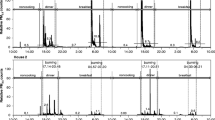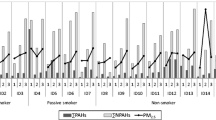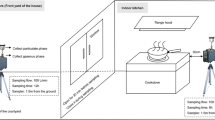Abstract
Personal and indoor exposure to PM2.5 and polycyclic aromatic hydrocarbons (PAHs) were measured in households in the Njombe district of Tanzania. Cooking is conducted indoors in this region due to its high elevation, cool climate, and heavy seasonal rainfall. Kitchens are often poorly ventilated, resulting in high exposures to combustion-related pollutants. Sampling sites were selected to represent typical cooking practices across regional socio-economic divisions. These include the use of open wood fires, charcoal, a mix of charcoal and kerosene, and liquid petroleum gas (LPG) for cooking fuels. PM2.5 average personal exposure was 14 μg/m3 (±3, n = 3) for LPG, 88 μg/m3 (±42, n = 3) for kerosene/charcoal mix, 588 μg/m3 (±347, n = 3) for charcoal alone, and 1574 μg/m3 (±287, n = 3) for open wood fires. Total PAH average personal exposures were less than 1 ng/m3 (±1, n = 3) for LPG, 57 ng/m3 (±16, n = 3) for kerosene/charcoal mix, 334 ng/m3 (±57, n = 3) for charcoal alone, and 5040 ng/m3 (±909, n = 3) for open wood fires. Benzo[a]pyrene equivalent exposures for US EPA’s priority PAH pollutants were 0 for LPG, 8 ng/m3 for kerosene/charcoal mix, 44 ng/m3 for charcoal, and 767 ng/m3 for open wood fire. Inhalable pollutants are present at unacceptably high levels, exceeding indoor air quality standards for all but LPG fuels. Relative results provide an exposure profile for rural East Africa and support the feasibility of conducting a larger scale smoke exposure campaign in the region. The use of “fuel efficient” wood stoves for the reduction of PM2.5 and PAH exposure was measured in a local secondary school. Proper use of “fuel efficient” wood stoves reduced personal and indoor exposure to measured pollutants by more than 90%, supporting further investigation into the applicability of this technology to significantly improve indoor air quality.
Similar content being viewed by others
References
Adonis, M., & Gil, L. (2001). Indoor air pollution in a zone of extreme poverty of metropolitan Santiago, Chile. Indoor and Built Environment, 10(3–4), 138–146.
Anderson, H. R. (2000). Differential epidemiology of ambient aerosols. Philosophical Transactions of the Royal Society A, 358(1775), 2771–2785.
Barregard, L., Sällsten, G., Andersson, L., Almstrand, A. C., Gustafson, P., Andersson, M., et al. (2008). Experimental exposure to wood smoke: Effects on airway inflammation and oxidative stress. Occupational and Environmental Medicine, 65(5), 319–324.
Blackden, C. M., & Gender, Q. W. (Eds.) (2006). Gender, time use, and poverty in sub-Saharan Africa, World Bank Working Paper No. 73 (pp. 55–57). Washington D.C.: World Bank Publications.
Bostrom, C. E., Gerde, P., Hanberd, A., Jernstrom, B., Johansson, C., Kyrklung, T., et al. (2002). Cancer risk assessment, indicators, and guidelines for polycyclic aromatic hydrocarbons in the ambient air. Environmental Health Perspectives, 110(3), 451–488.
CA EPA Office of Environmental Health Hazard Assessment (2005). Air toxics hot spots program risk assessment, part II: Technical support document for describing available cancer potency factors. http://www.oehha.ca.gov/air/hot_spots/pdf/May2005Hotspots.pdf. Accessed 5 February 2009.
Carlton, A. G., Turpin, B. J., Johnson, W., Buckley, B. T., Simcik, M., Eisenreich, J., et al. (1999). Microanalysis methods for characterization of personal aerosol exposures. Aerosol Science and Technology, 31, 66–80.
Chirone, R., Salatino, P., Scala, F., Solimene, R., & Urciuolo, M. (2008). Fluidized bed combustion of pelletized biomass and waste-derived fuels. Combustion and Flame, 155, 21–36.
Danielsen, P. H., Brauner, E. V., Barregard, L., Sallsten, G., Wallin, M., Olinski, R., et al. (2008). Oxidatively damaged DNA and its repair after experimental exposure to wood smoke in healthy humans. Mutation Research/Fundamental and Molecular Mechanisms of Mutagenesis, 642(1–2), 37–42.
Desai, A. M., Mehta, S., & Smith, K. R. (2004). Indoor smoke from solid fuels, assessing the environmental burden of disease at national and local levels: WHO environmental burden of disease series, No. 4. Geneva: World Health Organization.
Diaz, E., Bruce, N., Pope, D., Diaz, A., Smith, K. R., & Smith-Sivertsen, T. (2008). Self-rated health among Mayan women participating in a randomised intervention trial reducing indoor air pollution in Guatemala [electronic article]. BMC International Health and Human Rights, 8(7).
Dreher, D., & Junod, A. F. (1996). Role of oxygen free radicals in cancer development. European Journal of Cancer, 32A(1), 30–38.
Edelstein, M., Pitchforth, E., Asres, G., Silverman, M., & Kulkarni, N. (2008). Awarness of health effects of cooking smoke among women in the Gondar Region of Ethiopia: a pilot survey [electronic article]. BMC International Health and Human Rights, 8(10).
Engelbrecht, J. P., Swanepoel, L., Chow, J. C., Watson, J. G., & Egami, R. T. (2002). The comparison of source contributions from residential coal and low-smoke fuels, using CMB modeling, in South Africa. Environmental Science and Policy, 5(2), 157–167.
Finlayson-Pitts, B. J., Pitts, J. N. (2000). Chemistry of the upper and lower atmosphere. San Diego: Academic Press.
Gerde, P., Medinsky, M. A., & Bond, J. A. (1991). Particle-associated polycyclic aromatic hydrocarbons—a reappraisal of their possible role in pulmonary carcinogenesis. Toxicology and Applied Pharmacology, 108(1), 1–13.
Grobbelaar, J. P., & Bateman, E. D. (1991). Hut lung: A domestically acquired pneumoconiosis of mixed aetiology in rural women. Thorax, 46(5), 334–340.
International Energy Agency (IEA) (2006). World energy outlook 2006, chapter 15: Energy for cooking in developing countries. http://www.worldenergyoutlook.org/docs/weo2006/cooking.pdf. Accessed 10 October 2008.
International Energy Agency (IEA) (2009). World energy outlook 2009. Paris: OECD/IEA.
Kishore, V. V. N., & Ramana, P. V. (2000). Improved cookstoves in rural India: How improved are they? A critique of the perceived benefits from the National Programme on Improved Chulhas (NPIC). Energy, 27, 47–63.
Klaunig, J. E., Xu, Y., Isenberg, J. S., Bachowski, S., Kolaja, K. L., Jiang, J., et al. (1998). The role of oxidative stress in chemical carcinogenesis. Environmental Health Perspectives, 106(1), 289–295.
Kumar, R., Nagar, J. K., Kumar, H., Kushwah, A. S., Meena, M., Kumar, P., et al. (2008). Indoor air pollution and respiratory function of children in Ashok Vihar, Delhi: An exposure–response study. Asia-Pacific Journal of Public Health, 20(1), 36–48.
Kurmi, O. P., Semple, S., Steiner, M., Henderson, G. D., & Avres, J. G. (2008). Particulate matter exposure during domestic work in Nepal. Annals of Occupational Hygiene, 52(6), 509–517.
Larsen, J. C., & Larsen, P. B. (1998). Chemical carcinogens. In R. E. Hester, & R. M. Harrison (Eds.), Air pollution and health (pp. 33–56). Cambridge: The Royal Society of Chemistry.
Madajewicz, M., Pfaff, A., van Geen, A., Graziano, J., Hussein, I., Momotaj, H., et al. (2007). Can information alone change behavior? Response to arsenic contamination of groundwater in Bangladesh. Journal of Development Economics, 84(2), 731–754.
Mishra, V. (2003). Indoor air pollution from biomass combustion and acute respiratory illness in preschool age children in Zimbabwe. International Journal of Epidemiology, 32, 847–853.
Mishra, V., & Retherford, R. D. (2007). Does biofuel smoke contribute to anemia and stunting in early childhood? International Journal of Epidemiology, 36, 117–129.
Morozzi, G., Conti, R., Pampanella, L., Marchetti, M. C., Bucci, P., Scardazza, F., et al. (1997). Chemical analysis and biological activity of airborne particulate matter. Journal of Environmental Pathology Toxicology and Oncology, 16(2–3), 133–146.
Mumford, J. L., Li, X. M., Hu, F. D., Lu, X. B., & Chuang, J. C. (1995). Human exposure and dosimetry of polycyclic aromatic hydrocarbons in urine from Xuan Wei, China with high lung cancer mortality associated with exposure to unvented coal smoke. Carcinogenesis, 16(12), 3031–3036.
National Oceanic and Atmospheric Organization (NOAA) (2009). National weather service: Climate prediction center. http://www.cpc.ncep.noaa.gov/products/fews/AFR_CLIM/GRAPHS/Njombe_Tanzania.gif. Accessed 29 January 2009.
Naeher, L. P., Brauer, M., Lipsett, M., Zelikoff, J. T., Simpson, C. D., Koenig, J. Q., et al. (2007). Woodsmoke health effects: A review. Inhalation Toxicology, 19, 67–106.
National Bureau of Statistics (NBS) [Tanzania] and ORC Macro (2005). Tanzania demographic and health survey 2004–2005. http://www.measuredhs.com/pubs/pdf/FR173/02Chapter02.pdf. Accessed 10 October 2008.
Nisbet, I. C. T., & LaGoy, P. K. (1992). Toxic equivalency factors (TEFs) for polycyclic aromatic hydrocarbons (PAHs). Regulatory Toxicology and Pharmacology, 16, 290–300.
Oahn, N. T. K., Nghiem, L. H., & Phyu, Y. L. (2002). Emission of polycyclic aromatic hydrocarbons, toxicity, and mutagenicity from domestic cooking using sawdust briquettes, wood, and kerosene. Environmental Science and Technology, 36, 833–839.
Padhi, B. K., & Padhy, P. K. (2008). Domestic fuels, indoor air pollution, and children’s health: The case of rural India, in environmental challenges in the Pacific basin. Annals of the New York Academy of Sciences, 1140, 209–217.
Pope, A. C. (2008). Health effects of particulate matter air pollution. In Abstracts, joint 63rd northwest and 21st Rocky Mountain regional meeting of the American chemical society. Park City, UT, United States, June 15–18 2008.
Pope, A. C., Burnett, R. T., Thun, M. J., Calle, E. E., Ito, K., & Thurston, G. D. (2002). Lung cancer, cardiopulmonary mortality, and long-term exposure to fine particulate air pollution. Journal of the American Medical Association, 287(9), 1132–1141.
Raabe, O. (1999). Respiratory exposure to air pollutants. Lung Biology in Health and Disease, 129, 39–73.
Raiyani, C. V., Shah, S. H., Desai, N. M., Venkaiah, K., Patel, J. S., Parikh, D. J., et al. (1993). Characterization and problems of indoor pollution due to cooking stove smoke. Atmospheric Environment, Part A, 27A(11), 1643–1655.
Rollin, H. B., Mathee, A., Brce, N., Levin, J., & von Schirnding, Y. E. R. (2004). Comparison of indoor air quality in electrified and un-electrified dwellings in rural South African villages. Indoor Air, 14(3), 208–216.
Sallsten, G., Gustafson, P., Johansson, L., Johannesson, S., Molnar, P., Strandberg, B., et al. (2006). Experimental wood smoke exposure in humans. Inhalation Toxicology, 18, 855–864.
Simoneit, B. R. T. (2002). Biomass burning—a review of organic tracers for smoke from incomplete combustion. Applied Geochemistry, 17, 129–162.
Smith, K. R. (2002). Indoor air pollution in developing countries: Recommendations for research. Indoor Air, 12(3), 198–207.
Smith, K. R., & Liu, Y. (1994). Chapter 7: Indoor air pollution in developing countries. In J. Samet (Ed.), The epidemiology of lung cancer (pp. 151–184). New York: Marcel Dekker.
Smith, K. R., Sarnet, J. M., Romieu, I., & Bruce, N. (2000). Indoor air pollution in developing countries and acute lower respiratory infections in children. Thorax, 55, 518–532.
Smith-Sivertsen, T., Diaz, E., Pope, D., Lie, R. T., Diaz, A., McCracken, J., et al. (2009). Effect of reducing indoor air pollution on women’s respiratory symptoms and lung function: The RESPIRE randomized trial, Guatemala. American Journal of Epidemiology, 170(2), 211–220.
Sørensen, M., Autrup, H., Hertel, O., Wallin, H., Knudsen, L. E. , & Loft, S. (2003). Personal exposure to PM2.5 and biomarkers of DNA damage. Cancer Epidemiology Biomarkers & Prevention, 12, 191.
Southern Highlands Conservation Programme (SHCP) (2009). http://www.southernhighlandstz.org/southernhighlands.html. Accessed 29 January 2009.
Stone, D., Cole, E., & Wroe-Street, G. (2008). Assessing the effectiveness of fuel-efficient stove programming, a Darfur-wide review. http://www.proactnetwork.org/index.php/publications/reports/36-projectreports/112-fesreport. Accessed 29 January 2009.
Tesfaigzi, Y., Singh, S. P., Foster, J. E., Kubatko, J., Barr, E. B., Fine, P. M. , et al. (2002). Health effects of subchronic exposure to low levels of wood smoke in rats. Journal of Toxicological Sciences, 65, 115–125.
Terblanche, A. P., Nel, C. M., Opperman, L., & Nyikos, H. (1993). Exposure to air pollution from transitional household fuels in a South African Population. Journal of Exposure Analysis and Environmental Epidemiology, 3(1), 15–22.
United Nations Children’s Fund (UNICEF) (2006). World Health Organization: Pneumonia: The forgotten killer of children. http://www.unicef.org/publications/files/Pneumonia_The_Forgotten_Killer_of_Children.pdf. Accessed 3 March 2008.
USAID Academy for Educational Development (2008). Fuel-efficient stove programs in IDP settings: Summary evaluation report: Darfur, Sudan. http://www.usaid.gov/our_work/economic_growth_and_trade/energy/publications/EGAT0023.PDF. Accessed 29 January 2009.
U.S. Environmental Protection Agency (US EPA) (1998). Second supplement to compendium of methods for the determination of toxic organic compounds in ambient air. EPA-600/4-89-018 (pp. 13–19). North Carolina: Environmental Protection Agency.
U.S. Environmental Protection Agency (US EPA) (2006). Air and radiation: Particulate Matter: PM standards revision—2006. http://www.epa.gov/oar/particlepollution/naaqsrev2006.html. Accessed 23 January 2009.
Wichmann, J., & Voyi, K. V. V. (2006). Influence of cooking and heating fuel use on 1–59 month old mortality in South Africa. Maternal and Child Health Journal, 10, 553.
World Health Organization (WHO) (2000). Air quality guidelines for Europe. European series, No. 91 (2nd edn, p. 95). Copenhagen: WHO Regional Publications.
World Health Organization (WHO) (2005). The effects of air pollution on children’s heath and development: A review of the evidence. WHO Regional Office for Europe. http://www.euro.who.int/document/E83080.pdf. Accessed 22 January 2009.
World Health Organization (WHO) (2006). Development of WHO guidelines for indoor air quality. Report on a working group meeting, 23–24 October 2006. http://www.euro.who.int/Document/AIQ/IAQ_mtgrep_Bonn_Oct06.pdf. Accessed 3 March 2009.
Zhang, X., Smith, K.R. (2004). An assessment of programs to promote improved household stoves in China, August 2004 Summary Document (pp. 6). http://ehs.sph.berkeley.edu/hem/page.asp?id=29#1. Accessed 29 January 2009.
Zhang, J. J., & Smith, K. R. (2007). Household air pollution from coal and biomass fuels in China: Measurements, health impacts, and interventions. Environmental Health Perspectives, 115(6), 848–855.
Zhu, L., & Wang, J. (2003). Sources and patterns of polycyclic aromatic hydrocarbons pollution in kitchen air, China. Chemosphere, 50(5), 611–618.
Author information
Authors and Affiliations
Corresponding author
Electronic supplementary material
Rights and permissions
About this article
Cite this article
Titcombe, M.E., Simcik, M. Personal and indoor exposure to PM2.5 and polycyclic aromatic hydrocarbons in the southern highlands of Tanzania: a pilot-scale study. Environ Monit Assess 180, 461–476 (2011). https://doi.org/10.1007/s10661-010-1799-3
Received:
Accepted:
Published:
Issue Date:
DOI: https://doi.org/10.1007/s10661-010-1799-3




